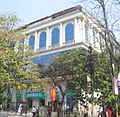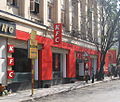Chowringhee | |
|---|---|
 Metropolitan Building near Chowringhee | |
 Location of Chowringhee in Kolkata | |
| Coordinates: 23°48′N88°15′E / 23.8°N 88.25°E | |
| Country | |
| State | West Bengal |
| City | Kolkata |
| District | Kolkata |
| KMC wards | 46, 63 |
| Metro Station | Esplanade, Park Street, Maidan and Rabindra Sadan |
| Kolkata Suburban Railway | Eden Gardens, Sealdah and B.B.D. Bagh |
| Elevation | 36 ft (11 m) |
| Population (2001) | |
• Total | 159,917 |
| Time zone | UTC+5:30 (IST) |
| PIN | 700013, 700016, 700071, 700087 |
| Area code | +91 33 |
| Lok Sabha constituency | Kolkata Uttar and Kolkata Dakshin |
| Vidhan Sabha constituency | Chowranghee and Bhabanipur |
Chowringhee (also Chourangi) is a neighbourhood of Central Kolkata, in Kolkata district in the Indian state of West Bengal. Chowringhee Road (officially Jawaharlal Nehru Road) runs on its western side. A neighbourhood steeped in history, it is a business district, [1] as well as a shopper's destination and entertainment-hotel centre. The area lies exactly at the centre of the city.








